Jyeṣṭhā, Scorpio, and Caroline Myss
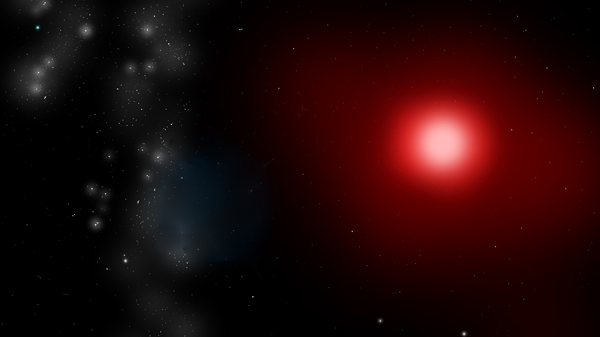
इन्द्रो ज्ये॒ष्ठामनु॒ नक्ष॑त्रमेति। यस्मि॑न् वृ॒त्रं वृ॑त्र॒तूर्ये॑ त॒तार॑।
तस्मि॑न्व॒यम॒मृतं॒ दुहा॑नाः। क्षुध॑न्तरेम॒ दुरि॑तिं॒ दुरि॑ष्टिम्।
पु॒र॒न्द॒राय॑ वृष॒भाय॑ धृ॒ष्णवे। अषा॑ढाय॒ सह॑मानाय मी॒ढुषे।
इन्द्रा॑य ज्ये॒ष्ठा मधु॑म॒द्दुहा॑ना।उ॒रुं कृ॑णोतु॒ यज॑मानाय लो॒कम्। ॥ १७ ॥
indro jyeṣṭhām anu nakṣatram eti |
yasmin vṛtraṃ vṛtratūrye tatāra |
tasmin vayam amṛtaṃ duhānāḥ |
kṣudhaṃ tarema duritiṃ duriṣṭim |
purandarāya vṛṣabhāya dhṛṣṇave |
aṣāḍhāya sahamānāya mīḍhuṣe |
indrāya jyeṣṭhā madhumad duhānā |
uruṃ kṛṇotu yajamānāya lokam || 17 ||
“Indra follows Jyeṣṭhā nakṣatra. Where he has overcome Vṛtra in the battle, there by milking Immortality we should overcome the Hunger, Difficulty and Defect in Sacrifice. For Indra, the Destroyer of the fortified cities, the Bull, the Violent, Powerful and Invincible, Conqueror and Bountiful Giver, Jyeṣṭhā nakṣatra by milking honey-sweetness should create the vast world for Yajamāna.”
That Mysterious Scorpio
If we had to choose which rāśi (constellation) in the Zodiac gets the nod for most dramatic, it would have to be Scorpio. In the natural birth chart, which starts with Aries in the first bhāva (house), Scorpio is the rāśi on the eighth bhāva. This is considered the most challenging bhāva in the chart and is often referred to in terms of death and transformation. This is also the bhāva of alternative and energetic healing modalities, psychic insight, and metaphysics. So, when Scorpio lands on the lagna (Ascendant), we have a native who is intense, deeply insightful, and in the right chart, someone who can have quite a transformational influence on those around them.
Another facet of Scorpio has to do with a little warning the ancients offered about this area of the sky. They gave it the name Via Combusta and described it as a hot, arid section of the zodiac
This region of “the Scorpion” contains three prominent but difficult-to-handle nakṣatras. Their natures have a certain edgy dominance and grahas placed here can have a stinging effect. These nakṣatras are Viśākhā, Anurādhā, and Jyeṣṭhā.
Red-Hot Jyeṣṭhā
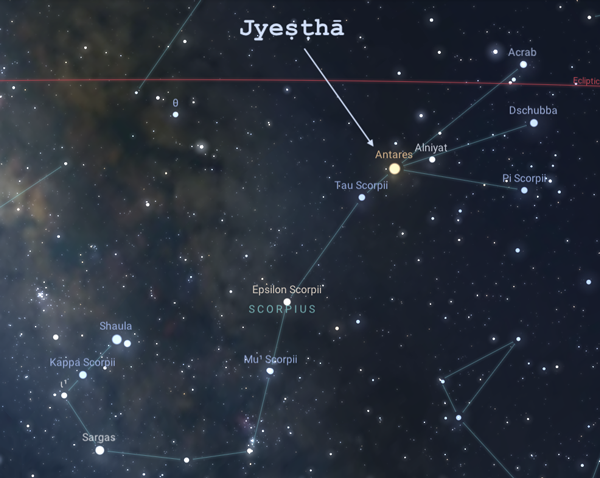
It’s important to note that the 27 nakṣatras of the zodiac, sometimes called the Mansions of the Moon, were the star groups mentioned in Veda rather than the solar zodiacal rāśis. The ancient star watchers tracked the grahas, especially the Moon, in the night sky by observing recurrent transits through a set of fixed star patterns. The most noticeable star of those patterns was called the yoga tārā or marking star. Sometimes a nakṣatra has more than one marking star. The ancients could see these star regions above and could track their influence on humanity as they moved through the sky.
Just as Scorpio can be considered among the most intense and dramatic of the 12 rāśis, so Jyeṣṭhā is considered among the most intense and dramatic of the 27 nakṣatras. Grahas here hold extreme potential. This is because Jyeṣṭhā’s ruling deity is Indra, the king of the gods and the ruler of heaven. Of all the universal devatas (deities), he is known to be the most powerful and is praised by all for his indominable courage and over-the-top exploits. In fact, of all the sūktas (hymns) of the Ṛg Veda (the oldest of the Vedas), Indra is the most praised.
The yoga tārā of Jyeṣṭhā is best known by its familiar name, Antares. It is located at 15°55’ Scorpio. It is the 15th brightest star in the night sky and shines a brilliant red in the very heart of the Scorpion. Although Jyeṣṭhā is technically in the 16°40’–30° span in Scorpio, there is no question that this is the marking star, even though it is slightly outside the zone. It outshines anything remotely close to it. Antares is one of the four royal stars of Persia as noted by diverse astrological traditions. All of Scorpio is in the aforementioned Via Combusta, adding more to the fiery nature of Jyeṣṭhā. Among its meanings are “The Eldest,” “Senior Most,” and “Most Excellent or the Most Praiseworthy.” Being the eldest or senior in a family can—especially in the Indian context—indicate the one that takes on the role of the poṣaka (protector, caretaker) of the family
For some nakṣatras, the very appearance of the star or stars of a nakṣatra can serve as a pratimā (symbol) for the nakṣatra. For Jyeṣṭhā, the pratimā is taken as a talisman, strongly suggesting something magical, occult, and protective.
Indra-Superman of the Vedas
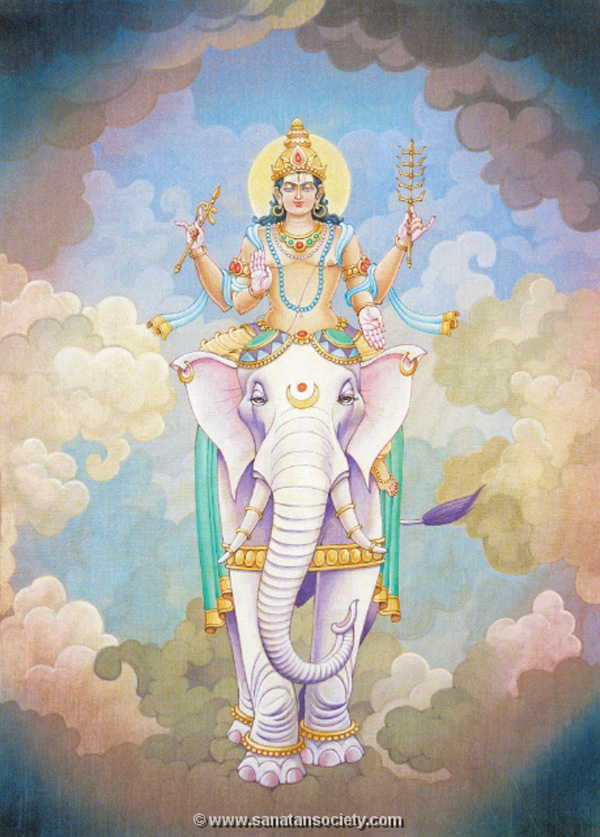
The devata for each nakṣatra is indicated in the Veda itself by the ancient ṛṣis (seers). We can think of these deities as different laws or governing principles of Nature. Much of a nakṣatra’s meanings, therefore, can be derived from the character of that specific devata.
Indra is might personified—the ultimate warrior—leading the other gods in the battle against darkness and evil. He is a brave, noble, and generous hero who is not afraid to use force, if necessary, in order to prevail and achieve supremacy. He is considered the protector of the worlds and as the king of the gods, their well-being is his responsibility. This is additional confluence that this nakṣatra is linked to the concept of poṣaka. After all, “with great power comes great responsibility.”
For example, Indra is greatly praised in the Vedas for his resounding defeat of the mighty destructive force, Vṛtra, the demon of drought, who was choking the universe. He not only killed Vṛtra, but in an outlandish statement of his power, left his body dismembered on the battlefield. Emboldened by his great victory, he went on to slay many other demons, who were obstructors of dharma.[1]
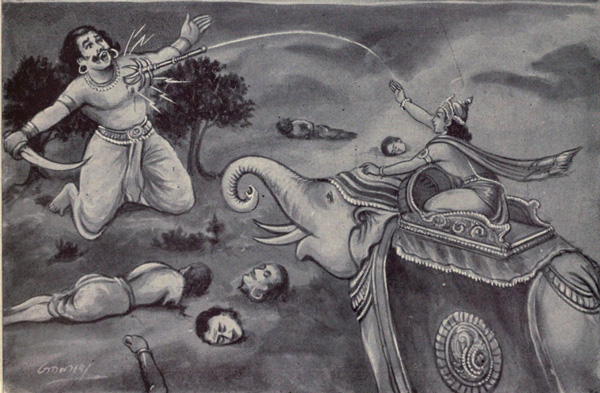
Indra wears a magical talisman into battle, which allows him to defy the odds and be assured of victory.[2] It also gives him mastery of the magical arts. Therefore, a native with important placements in this nakṣatra can often be shrouded in secrecy and mystery, and there can even be something occult or magical about their life.
And at the same time, Indra is audacious and street savvy. He is daring, risk-taking, and unstoppable but can be quite puffed-up with his prowess and power. Any or all of these qualities might also come through in the personality of people where this nakṣatra is prominent, including displaying an overabundance of confidence. Indra is known to get intoxicated on the mythical soma juice (nectar of immortality), which invigorates him to perform great deeds and brings him to a state of inspiration and communication with the divine. So, too, people with this nakṣatra tend to have mystical aspirations, but on the downside, troubles with addictions. Known to be a very virile and passionate lover, Indra regularly gets into big trouble with his lack of discrimination over whom he goes after. Therefore, the Jyeṣṭha native might be well advised to cultivate restraint and good judgement lest they become derailed by scandals.
The All-Important First Bhāva
The qualities that describe Indra are those that we often see in a person who has a Scorpio lagna and Jyeṣṭhā nakṣatra configured with the Ascendant point or with Mars, the owner of the first bhāva. Though any graha or grahas prominently placed in Jyeṣṭhā can also reflect these traits, the first bhāva is all-important because it is the primary definer of the person’s character and personality, their motivations, and their ability to successfully navigate the world.
To illustrate the above qualities of both the Scorpio lagna and the Ascendant point in Jyeṣṭhā nakṣatra, we will look at the chart of best-selling author, Caroline Myss (pronounced “Mace”).
Caroline Myss December 2, 1952 08:01 Chicago, IL, USA [3]
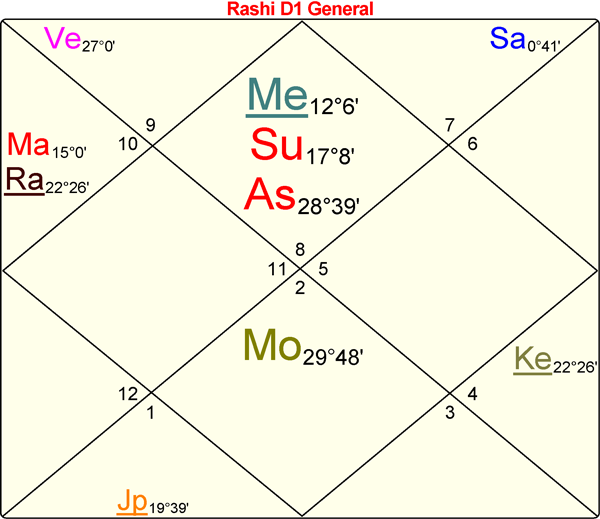
Caroline Myss is a modern-day mystic and a pioneer in the field of medical intuition. She developed the field of Energy Anatomy, a science that correlates specific emotional/psychological/physical/spiritual stress patterns with diseases.
What Sets Caroline Myss Apart
It’s important to note that while many people might have their lagna in Scorpio and their Ascendant point in Jyeṣṭhā, they don’t necessarily display the type of dominance, leadership, and fame attributed to the king of the devas, Indra, nor the insight, transformational power, and healing abilities ascribed to Scorpio. So, it is important to consider what additional astrological factors make Caroline Myss stand out as such a pre-eminent leader in her field.
The first thing to look for is this: Are any of the above-mentioned factors on or near the yoga tārā of Jyeṣṭhā, the big, bright-red Antares. This would intensify the indications of Jyeṣṭhā as they accrue to the personality. Caroline’s Ascendant point is in Jyeṣṭhā, but it is her Jyeṣṭhā Sun, the lord of the tenth bhāva of authority, fame, and achievements, that is close to the exact degree of Jyeṣṭhā’s yoga tārā.

The second thing we would look for is the strength of the first bhāva and first lord. This tells us how strong the person’s sense of self is—their character and their ability to project themself into the world. Strength of these factors would also demonstrate the person’s ability to take advantage of whatever comes to them, both positive and challenging. As already mentioned, Caroline has her graha of power and authority, the Sun, in the lagna, but what is even more significant is the condition of her lagneśa (Ascendant lord), Mars. Not only is it ucca (exalted) in the third bhāva of motivation and courage, but the owner of the rāśi that Mars sits in is an ucca Saturn, giving Mars great supportive strength. This support gets further extended by Saturn sitting in Venus’s rāśi, who becomes strong by virtue of being vargottama (in the same rāśi in the natal chart and the key ninth divisional chart).[4] The vargottama strength is perfected by the strength Venus gets from its rāśi dispositor, Jupiter, who is retrograde and therefore very bright.[5] [6]This succession of strengths is not something often seen in a chart.
The third factor that would show a person’s impact on the world is the abundance of positive yogas (auspicious combinations). Along with the knowledge of the nakṣatras, yogas are one of the standout features of Vedic Astrology and can take an otherwise average chart and raise it way above the norm. Caroline Myss has an amazing seven Rāja (kingly) Yogas, another rarity.[7] Such yogas are capable of conferring success, preeminence, and high stature to the native. Five of these are configured with her exalted, full Moon. The Moon is the graha associated with nurturing, sensitivity, receptivity, and instincts, as well as recognition and fame from the public; and her very strong and yogic Moon happens to sit in the seventh bhāva of the public. She has many other yogas, as well. Her double-strong[8] Mercury and Sun in the first bhāva form a Budhāditya Yoga, a configuration for brilliance. She has at least four Dhana yogas (yogas for wealth and good fortune) including a highly valued Lakṣmī Yoga. In addition, there is a strong and well-conditioned Śaṅkha Yoga, which gives her the ability to use her intelligence, tact, and good judgement in dealing with difficult people or challenging situations.[9]
The Time of Her Life: Rāhu Daśā
The daśās (graha periods) and bhuktis (subperiods) in a person’s chart show the evolution of the experiences they are destined to have in life[10]. Caroline began to experience the unfolding of her unique talents early in life—in her Rāhu daśā. Rāhu is a graha that can indicate the unusual, the out-of-the-ordinary, or even the mystical (reflective of Indra’s mystical experiences). As a girl, while driving around town with her mother, little Caroline would point out the houses where there was someone sick inside or where the family was unhappy. Her mother recognized and encouraged these abilities and “she was wonderful about telling me to talk to God about what Heaven wanted me to do with my gift.”[11]
Rāhu also sits with lagneśa Mars in the third bhāva of communication, writing, skill, and prowess, and they are both in Śravaṇa, a nakṣatra that tends to give a very wise and discriminating intellect, a love of communication, and an ability to see the subtle relationships between diverse concepts, people, and things.
It was in this period that she was very impacted by death and war and committed, at a very early age, that she would do everything in her power to help lift the scourge of war and violence from the planet. Again, we see the influence of Indra leading the battle against darkness and evil.
Formalizing Her Gift in Jupiter
It is important to note that Mars not only owns the first bhāva but also the sixth bhāva of health and healing—and because of its aspect into its own rāśi in the sixth, it positively promotes the affairs of that bhāva. When she left her Rāhu daśā at 21 years of age, she entered Jupiter, the graha of deep, cognitive knowing. It’s fascinating that Jupiter happens to sit in her sixth bhāva and it was in this period that she began to formally develop her medical intuitive skills.
At first, she thought of these abilities as an aside, as she was more interested in her journalistic pursuits, but she eventually realized she didn’t have the talent nor the enthusiasm to be a great journalist. Other inclinations began to surface during the spiritualizing Jupiter daśā, and she decided on another focus. She went back to school and got her master’s degree in Theology during Jupiter (daśā)/Mercury (bhukti). Mercury owns the eighth bhāva of mysticism which fed a deep, inner desire to “know” the truth. She says of this time, “I became fascinated with understanding, where does our life journey begin? What influences us? Do we have agreements or contracts that are made before this life begins?”[12]
She began a publishing career in Jupiter/Venus focusing on human consciousness and holistic health. Like Indra, her true prowess was so natural that she took her medical intuitive abilities for granted, that is until her reputation would no longer allow her to discount them. It seems one rarely heard the term ‘medical intuitive’ before the early ‘80s. It was Caroline Myss who not only pioneered the subject but brought it to a place of prominence in the modern American awareness.
Finding Her Voice and Creative Expression
In Caroline’s chart, her new daśā lord, Jupiter, owns the second bhāva of speech and the fifth bhāva of creativity. During this time, she began collaborating with well-known MDs in the Alternative or Complementary Healing fields, like Dr. Christiane Northrup, MD, and Dr. Norm Shealy, MD, PhD; she even co-authored books with Dr. Shealy. The ability to form productive alliances to achieve one’s goals is one of the prime indicators of Anurādhā, the nakṣatra that her very strong Mercury in the first occupies. Mercury happens to be the graha of communication and conveying a message.
She eventually began writing books on her own in the field of energy medicine and healing and achieved great success and renown as an author. Not many people can claim to have written ten books, five of which are on The New York Times Best Sellers list. She has become one of the most in-demand ‘gurus’ in the self-help market. This primacy in her field is reflective of Indra’s supremacy.
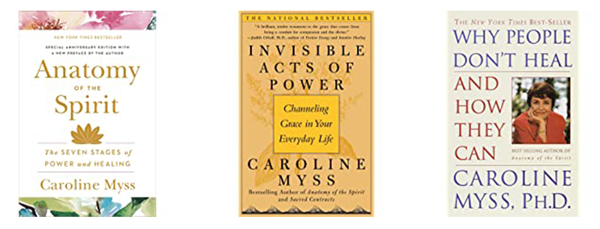
A Bit Contrarian
Indra, for all his positive qualities, was also a picture of contradictions, addictions, foibles, and flaws. Caroline has those contradictions, as well. She smoked, she drank pots full of coffee, never exercised, and ate whatever she felt like and she refused to meditate. She suffered from chronic back pain, chronic fatigue syndrome, and headaches so severe they made her vomit.[13]
And like Indra, she always thought she was right, so when colleagues told her that perhaps her inner child needed healing, she told them they were “nuts.”[14] This tendency to consider herself the accurate assessor of what’s real and true is also reflected in her chart by the aspect of an ucca Saturn onto her Jupiter. Though this can give wisdom, it can also create a distorting influence on the truth (Jupiter)—just enough to create critical lapses in judgement. But she is aware of this aspect of herself. “It needs to be said I’m working as hard as everyone else at maintaining my own integrity and not pointing fingers at others. I have to keep an eye on myself all the time.” And she admitted that “she couldn’t fix herself, but [she was] becoming very good at fixing others.”[15]
Saturn—A Great Time for Exploring the “Wound”
When she went into the daśā of her ucca Saturn in the early ‘90s, she stopped working as a medical intuitive and began focusing on teaching workshops to show people how to maintain their health and understand the cause of their ill-health. Many of her best-selling books were written during her Saturn period, focusing on life purpose, archetypes, and the cakras (energy centers), as well as other metaphysical subjects.
True to her Scorpio nature, she has the uncanny ability to penetrate into the hidden realms of human nature. The eighth bhāva, which Scorpio reflects, is the bhāva of the hidden, therefore the bhāva of the unconscious—the place our wounds and traumas like to hang out. Part of Myss’s philosophy about healing is something she calls “Woundology,” the idea that holding on to old wounds gives people their identity, a sense of power, and justification for being the way they are. It’s an excuse for not living their lives. They use their illness to manipulate the world around them, in contrast to those who see their health as their responsibility and adopt a more empowered attitude toward their health. This syndrome has actually come to be recognized as a psychological condition.
Like so much of Myss’s knowledge, such realizations came to her in flashes of insight (like Indra’s thunderbolt). “What I recognized is that healing represents change, and people would rather be abducted by aliens than change their lives.” She adds, “I’m not saying no one wants to heal; that’s nonsense. I’m talking about people who have found the ‘street value’ of their wounds. If we do something wrong, the wounds go on trial, not us.”[16]
A Straight Shooter

You can see from the above statement that her presentation is quite direct, humorous, and a little sarcastic and skeptical. She has a weirdly down-to-earth, tell-it-like-it-is approach to mysticism. She is just as comfortable challenging the irrationality of Evangelicals as she is the entitlement of New Agers.
What is significant about her ability is that she could not only tell her clients what was wrong with them physically, but with great Scorpio insight, why they were sick—the underlying emotional or spiritual blocks that were creating their disease.
And reminiscent of Indra’s love of power, Caroline says about herself, “I love the invisible power. I can totally change someone’s life. It fills me up. It keeps me sharp. It tells me I’ve still got it.”[17]
An Uncommon Mystic
Caroline also has a unique view of the Divine. “For me, God is law. I would never say God is love. For me, God is law and order. That’s how transcendent mystical cosmic love shows itself, as an order of justice and consistency.”[18] In a certain way, this mirrors an important quality of Indra. He is the law. He keeps the order and he metes out justice in his rulership over heaven and earth. And he is always on red alert to go to battle against the forces of darkness.
Similarly, Caroline reflected on the state of the world saying, “This world is filled with psychic free radicals. In mystical language, it’s filled with darkness. In another century, I would have called it demons. Anyone who speaks the language of the soul knows exactly what I’m talking about. Somebody dare tell me they don’t believe in evil. Open your eyes and see it everywhere. We have morphed to accommodate darkness.”[19]
And when commenting on what has been going on in this country and around the world in recent years, she says she has passed being saddened, but is now feeling shattered by it. “What’s hard for me is dealing with injustice. I will devote my life to this not happening. What do I need to do? What do you want me to do? This cannot happen again.”[20]
Transformation and Life Purpose
Her deep Scorpionic commitment to transformation is shown when commenting on the Western mind’s need to define itself in terms of material accomplishment. “Such a value system doesn’t embrace an understanding of the mystical purpose of life—which is the empowerment of the soul. This happens through a complex of life experiences and relationships that include an obligation to give something to life before you leave it.”[21]
The true understanding of “life purpose” is to assist in the transformation of life—and nature—to make the world a better place. For Caroline, our life purpose is to “learn the power of courageous choices. It’s a mystical quest not a physical one, what am I here to learn, what am I supposed to contribute to my soul and to the lives of others? These are the deeper questions to ask of ourselves. Life is about engaging in a more responsible pattern of cause and effect—action and reaction. A conscious choice makes awareness more acute. A conscious choice makes the responses to intuitive signals sharper. It means that I will not be able to be chronic again. There is no such thing as a small or insignificant conscious choice.”
“In this regard, healing is a conscious choice. It’s about letting go of the past and forgiving. Forgiveness returns us to the power of the present moment, which is where healing takes place.”[22]
Mercury-So Much Yet to Communicate
Caroline Myss is now in her Mercury daśā. Her strong Budhāditya Yoga has her continuing to write, speak, and teach—writing more books, offering international workshops and, to date, producing more than 80 audio/visual products on subjects that include healing, spirituality, personal development, and the study of archetypes. She even has her own YouTube channel.
A True Poṣaka
So much of Caroline Myss’s life is reflective of her Scorpionic nature, which has given her great insight and the ability to see how life’s suffering can be transmuted into freedom. It was also reflective of Jyeṣṭhā’s quality of being the Senior Most, the Poṣaka, or Protector, and being willing to accept responsibility for the greater whole. Finally, her life mirrored many of Indra’s great and noble qualities, his passion, and his victorious achievements, but also his deeply mystical nature.
Nothing better describes how Caroline has imbibed Indra’s Poṣaka nature than the advice she gives those who look to her for guidance. “You have to live and breathe and be the change you want to see happen in the world. That is the true spiritual path—it’s a path of action. It’s a path of congruence, it’s a path of courage. Courage and prayer are the missing ingredients. Courage is the capacity to be an integral person—to stand up for people, to take a position on things, to be an activist. We need to pray not just during times of emergencies, we need to pray for more than just more stuff! We need to pray for others. We are in this journey together. All life breathes together.”[23]
Author: Jonathan Crews

Jonathan Crews has had a lifelong fascination with the Vedic wisdom of India. He has practiced and taught meditation, yoga, and Vedic Science around the world for the last 45 years. He helped renowned Ayurvedic physician, Dr. Sunil V. Joshi author the book, Ayurveda and Panchakarma: The Science of Healing and Rejuvenation. He has been practicing Vedic Astrology for the last 20 years and is a Professional Coach. He has combined these two approaches in order to assist his clients in finding and manifesting their gift or life purpose. He has a BA in Psychology and an MBA.
Acknowledgments:
Hart de Fouw for elucidating the 27 Nakṣatras.
Penny Farrow for further elaborating the wisdom of these unique aspects of Vedic Astrology.
Radhe for her master work on the Nakṣatras, The Divine Force of the Lunar Nakṣatras.
Endnotes:
-
Ṛg Veda 1.32.3 ↑
-
Atharvaveda 8.53.3, 12: “With this talisman Indra slew Vṛtra…he destroyed the asuras, he conquered both the heaven and earth, he conquered the four regions of space. He that wears this talisman, verily is a tiger, a lion…and a bull; moreover, a curtailer of enemies.” ↑
-
Caroline Myss Birth Data December 2, 1952 at 8:01 in Chicago, Illinois courtesy of Astrodatabank. ↑
-
Penny Farrow. "Divisional Charts: A Fine Family or a Rowdy Brood." The Mountain Astrologer, October/November: 16. ↑
-
Bootes, Lynn. 2020. “Going Retro” vedicchart.com. September 9. Accessed April 2021. vedicchart.com. ↑
-
Borrowed Strength: When a graha’s dispositor has strength, gained from being sva rāśi, exalted, vargottama, retrograde, or full Moon, the graha, in essence, borrows strength from its dispositor, becoming more effective itself as a result. ↑
-
Rāja Yogas referenced in this chart are from Bṛhat Pārāśara Horā Śāstra (BPHS) Ranjan Publications or Phaladīpikā (PD) Sagar Publications. The yogas are as follows: :
1. Lords of the ninth and tenth bhāvas in mutual aspect BPHS 39:37
2. Full Moon in a kendra other than first bhāva PD 7:7
3. Exalted, full Moon PD 7:22
4. Exalted graha aspected by a friend PD 7:21 (modified)
5. Three exalted grahas BPHS 39:44
6. Eleventh lord in a kendra to the Moon while Jupiter owns the second bhāva PD 7:25
7. Lords of the fourth and fifth bhāvas in mutual aspect BPHS 39:37 ↑
-
Mercury has dig bala (directional strength) in the first bhāva and is retrograde. ↑
-
Lakṣmī Yoga The 9th lord, Moon, is exalted and the lagna lord, Mars, is strong. Indicates great wealth, fortune, health, and generosity. BPHS 36:27-28
Śaṅkha Yoga Strong lagna lord with the 5th and 6th lords in kendras to each other. Indicates one who utilizes their intelligence, good judgement, tact, diplomacy, and negotiating skills when it comes to dealing with conflict, difficult people, or financial situations. BPHS 36:13-14 ↑
-
Farrow, “Cosmic Duets: Enthralling Harmonies or Yowling Cats” in The Mountain Astrologer, June/July 2018 p. 18 ↑
-
Sidon, R. (2017/2018, December/January). Caroline Myss: Mission of a Modern Mystic. The Common Ground, pp. 42-49. ↑
-
Ibid. ↑
-
Lavin, C. (1998, June 21). Early Diagnosis. Chicago Tribune. ↑
-
Ibid. ↑
-
Ibid. ↑
-
Ibid. ↑
-
Ibid. ↑
-
Ibid. ↑
-
Sidon, R. (2017/2018, December/January). Caroline Myss: Mission of a Modern Mystic. The Common Ground, pp. 42-49. ↑
-
Ibid. ↑
-
Ibid. ↑
-
Ibid. ↑
-
Ibid.
Photo and Illustration Credits:
Andreo, Regelio Bernal. From the Galactic Plane through Antares by Rogelio Bernal Andreo (www.deepskycolors.com) licensed by BY-NC-ND Creative Commons.
Esperanza, J. 2021. Jonathan Crews.
Harmony, an Imprint of Penguin Random House. Caroline Myss titles. https://www.myss.com/product-category/offsite-products/ Accessed April 30, 2021.
Myss.com. Caroline Myss. https://www.myss.com. Accessed April 21, 2021.
Weltevrede, Pieter. Indra. sanatansociety.com. https://www.sanatansociety.com/indian_art_galleries/hg_indra_paintings.htm. Accessed April 21, 2021.
wemystic.com. Scorpion constellation. https://www.wemystic.com/full-moon-in-scorpio/. Accessed April 21, 2021.
Ramanarayanadatta astir. Story of Vritra .Public domain of India. https://commons.wikimedia.org/wiki/File:Story_of_Vritra_(cropped).jpg. Accessed April 30, 2021.
Sephirohq, CC BY-SA 3.0 via Wikimedia Commons
Shri Jyoti Star software 9.0.
Works Cited:
n.d. "astrodatabank." astro.com. Accessed April 21, 2021. https://www.astro.com/adb-search.
Bootes, Lynn. 2020. The Cosmic Kaleidoscope Journal. September 9. Accessed April 2021. https://vedicchart.com/cosmic-kaleidoscope-journal/going-retro/.
de Fouw, Hart & Robert Svoboda. 1996. Light on Life. Twin Lakes, WI: Lotus press.
Farrow, Penny. 2018. "Cosmic Duets: Enthralling Harmonies or Yowling Cats." The Mountain Astrologer, June/July: 18.
—. 2017. "Divisional Charts: A Fine Family or a Rowdy Brood." The Mountain Astrologer, October/November: 16.
Kapoor, Dr. G.S., translation/commentary/annotation. 2020. Phaladīpikā . New Delhi: Ranjan Publications.
Lavin, Cheryl. 1998. "Early Diagnosis." Chicago Tribune, June 21.
R. Santhhanam, translator/commentary/editing. 2018. Bṛhat Pārāśara Horā Śāstra . New Delhi: Ranjan Publications .
Radhe. 2014. The Divine Forces of the Lunar Nakshatras: as Originally Portrayed in the Vedas. CreateSpace Independent Publishing Platform.
Sidon, Rob. 2017/2018. "Caroline Myss: Mission of a Modern Mystic." The Common Ground, December/January: 42-49. ↑













